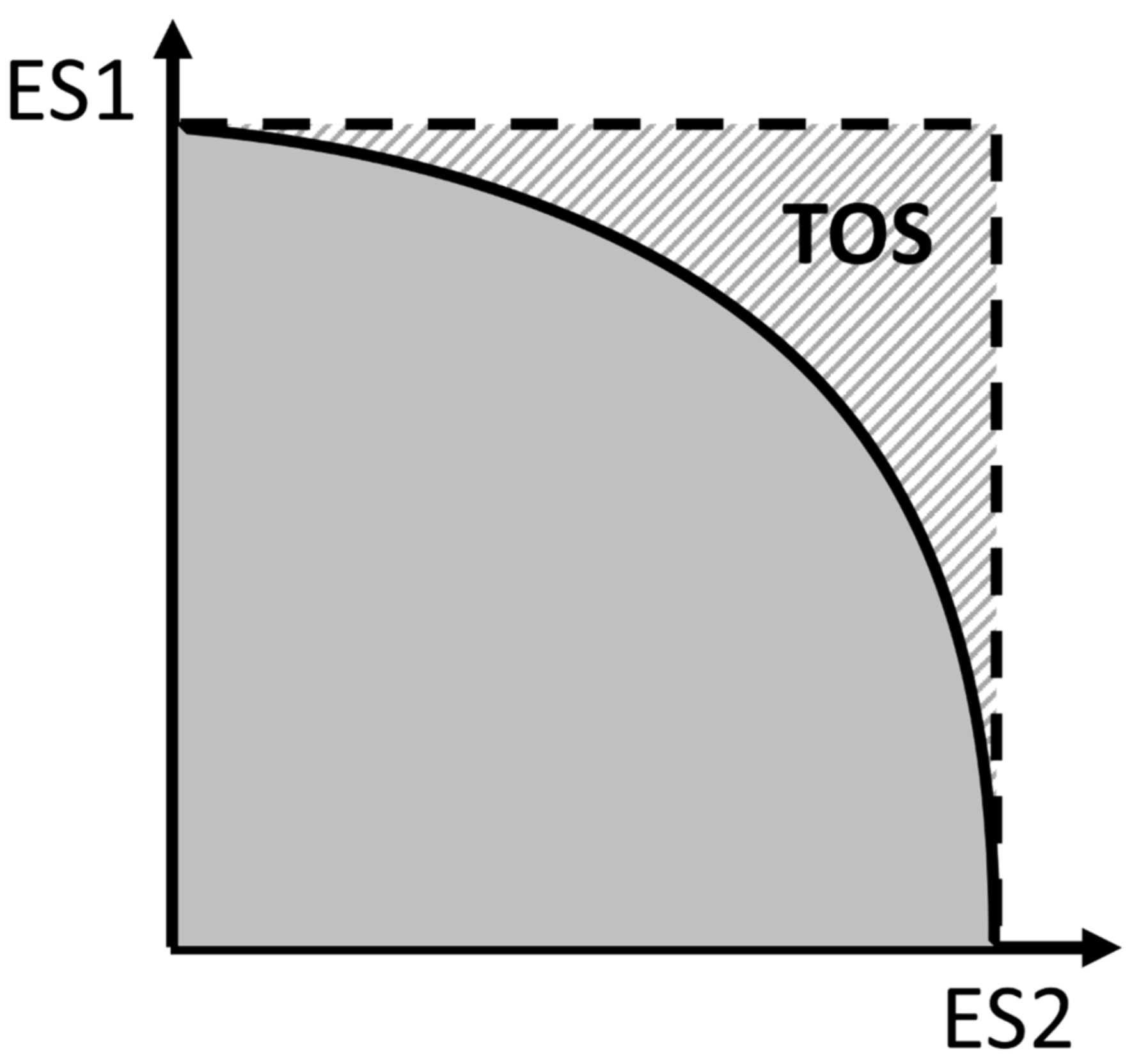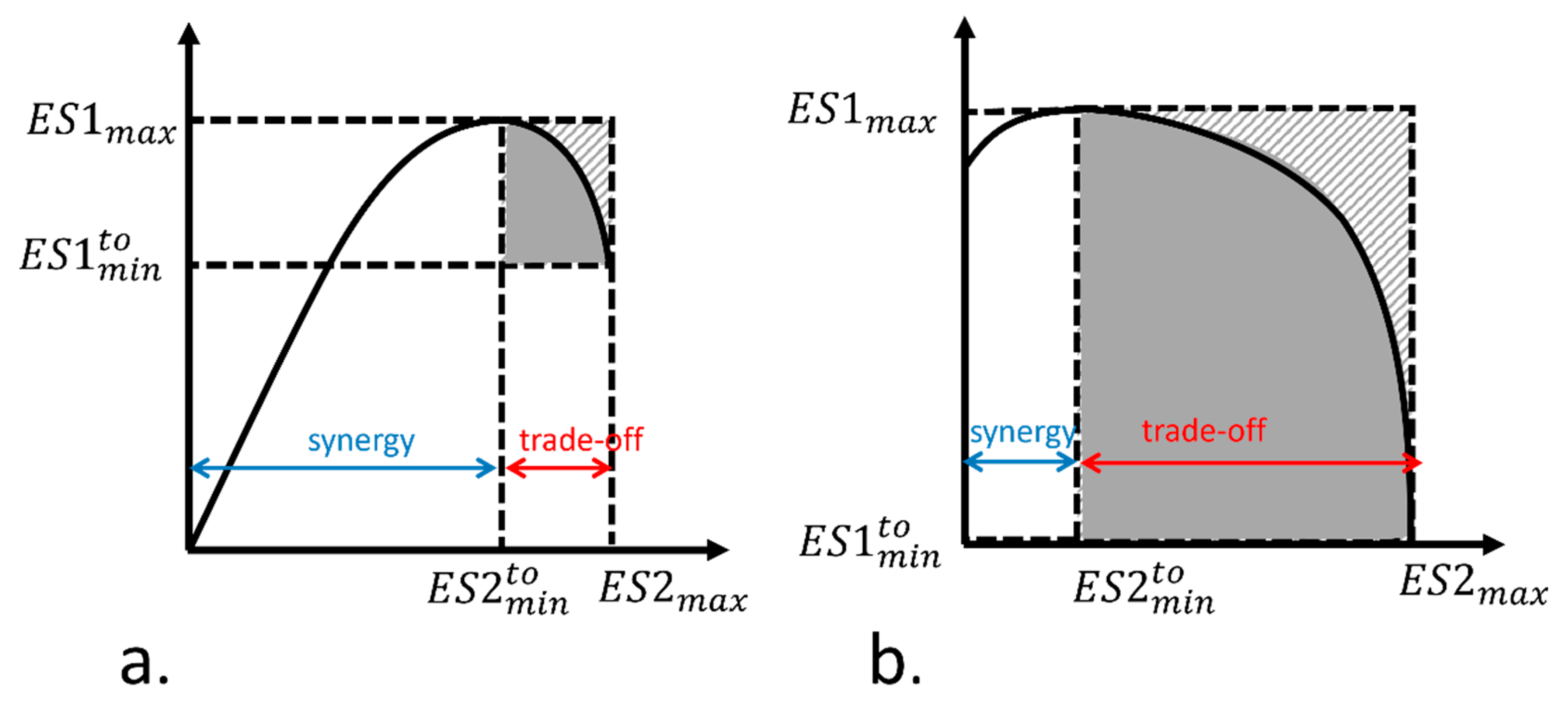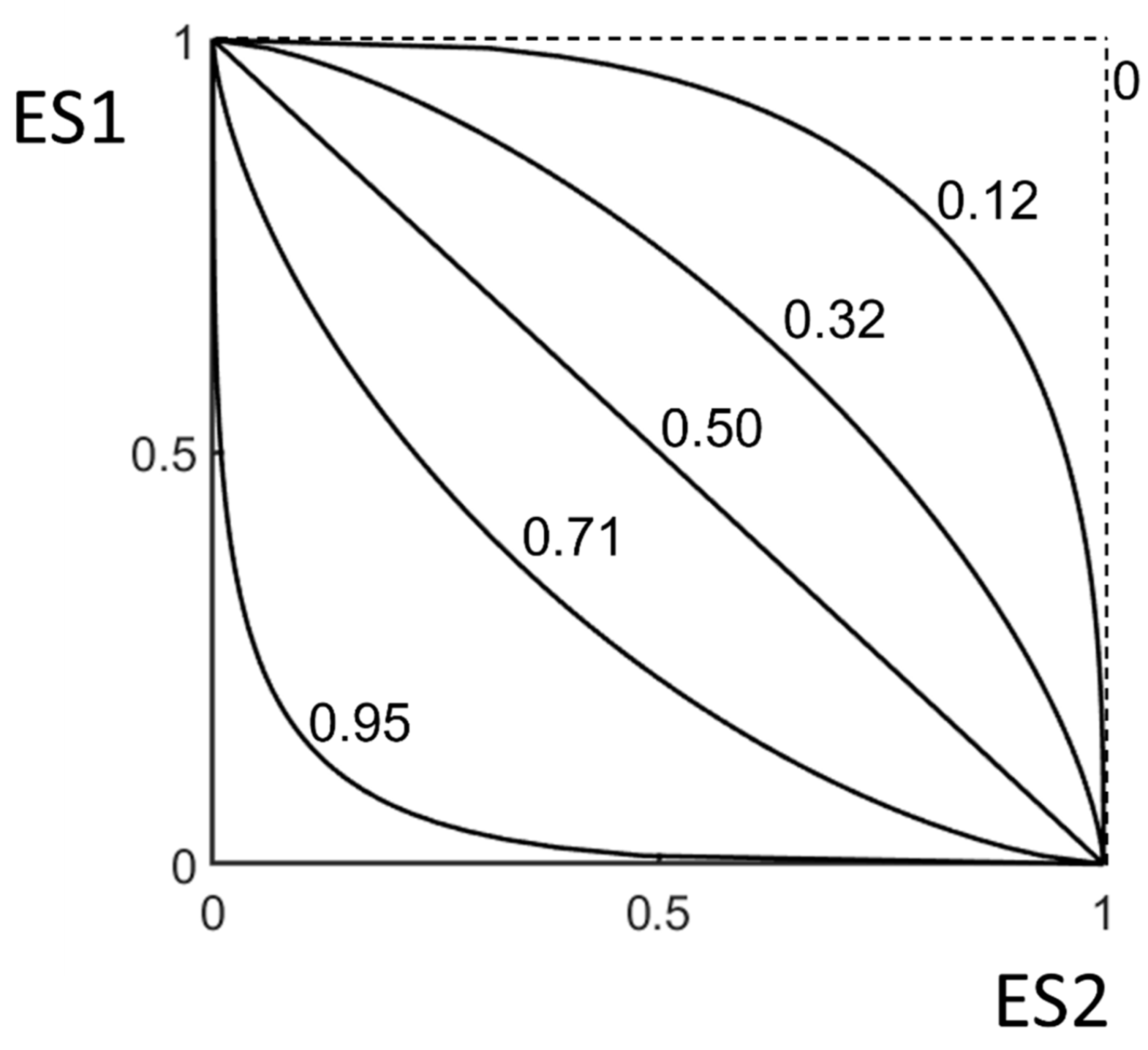Trade-Offs in Ecosystem Services: Clarifying Concepts and Measuring Severity within the Production Possibility Frontier Framework
Abstract
:1. Introduction
- What exactly is trade-off in the PPF context?
- How to effectively measure and compare trade-offs across PPFs?
2. What Exactly Is Trade-Off in the PPF Context?
3. How to Measure Trade-Off Severity of a PPF?
3.1. Requirements on a Generic Whole-Curve Trade-Off Severity Measure
- The measure should be suited for comparing nested curves with coinciding or non-coinciding intercepts (the scales of the curve axes need not be normalized).
- The measure should be able to handle crossing curves.
- The measure should account for the relative range of trade-off.
- The measure should not be limited to curves generated by any particular mathematical function.
3.2. Current Approaches
4. A Generic Whole-Curve Trade-Off Severity Measure
5. Example
6. Conclusions
Funding
Acknowledgments
Conflicts of Interest
References
- Bakx, T.R.; Trubins, R.; Eggers, J.; Akselsson, C. The effect of spatial and temporal planning scale on the trade-off between the financial value and carbon storage in production forests. Land Use Policy 2023, 127, 106583. [Google Scholar] [CrossRef]
- Bekele, E.G.; Lant, C.L.; Soman, S.; Misgna, G. The evolution and empirical estimation of ecological-economic production possibilities frontiers. Ecol. Econ. 2013, 90, 1–9. [Google Scholar] [CrossRef]
- Björklund, J.; Limburg, K.E.; Rydberg, T. Impact of production intensity on the ability of the agricultural landscape to generate ecosystem services: An example from Sweden. Ecol. Econ. 1999, 29, 269–291. [Google Scholar] [CrossRef]
- Cavender-Bares, J.; Polasky, S.; King, E.; Balvanera, P. A sustainability framework for assessing trade-offs in ecosystem services. Ecol. Soc. 2015, 20, 56. [Google Scholar] [CrossRef]
- Cord, A.F.; Bartkowski, B.; Beckmann, M.; Dittrich, A.; Hermans-Neumann, K.; Kaim, A.; Lienhoop, N.; Locher-Krause, K.; Priess, J.; Schröter-Schlaack, C.; et al. Towards systematic analyses of ecosystem service trade-offs and synergies: Main concepts, methods and the road ahead. Ecosyst. Serv. 2017, 28, 264–272. [Google Scholar] [CrossRef]
- DeFries, R.S.; Foley, J.A.; Asner, G.P. Land-use choices: Balancing human needs and ecosystem function. Front. Ecol. Environ. 2004, 2, 249–257. [Google Scholar] [CrossRef]
- Deng, X.; Li, Z.; Gibson, J. A review on trade-off analysis of ecosystem services for sustainable land-use management. J. Geogr. Sci. 2016, 26, 953–968. [Google Scholar] [CrossRef]
- Egas, M.; Dieckmann, U.; Sabelis, M.W. Evolution Restricts the Coexistence of Specialists and Generalists: The Role of Trade-off Structure. Am. Nat. 2004, 163, 518–531. [Google Scholar] [CrossRef]
- Haight, A.D. Diagram for a small planet: The Production and Ecosystem Possibilities Curve. Ecol. Econ. 2007, 64, 224–232. [Google Scholar] [CrossRef]
- Hegwood, M.; Langendorf, R.E.; Burgess, M.G. Why win–wins are rare in complex environmental management. Nat. Sustain. 2022, 5, 674–680. [Google Scholar] [CrossRef]
- Hopkins, S.R.; Sokolow, S.H.; Buck, J.C.; De Leo, G.A.; Jones, I.J.; Kwong, L.H.; LeBoa, C.; Lund, A.J.; MacDonald, A.J.; Nova, N.; et al. How to identify win–win interventions that benefit human health and conservation. Nat. Sustain. 2021, 4, 298–304. [Google Scholar] [CrossRef]
- Juutinen, A.; Saarimaa, M.; Ojanen, P.; Sarkkola, S.; Haara, A.; Karhu, J.; Nieminen, M.; Minkkinen, K.; Penttilä, T.; Laatikainen, M.; et al. Trade-offs between economic returns, biodiversity, and ecosystem services in the selection of energy peat production sites. Ecosyst. Serv. 2019, 40, 101027. [Google Scholar] [CrossRef]
- King, E.; Cavender-Bares, J.; Balvanera, P.; Mwampamba, T.H.; Polasky, S. Trade-offs in ecosystem services and varying stakeholder preferences: Evaluating conflicts, obstacles, and opportunities. Ecol. Soc. 2015, 20, 15. [Google Scholar] [CrossRef]
- Lee, H.; Lautenbach, S. A quantitative review of relationships between ecosystem services. Ecol. Indic. 2016, 66, 340–351. [Google Scholar] [CrossRef]
- Lester, S.E.; Costello, C.; Halpern, B.S.; Gaines, S.D.; White, C.; Barth, J.A. Evaluating tradeoffs among ecosystem services to inform marine spatial planning. Mar. Policy 2013, 38, 80–89. [Google Scholar] [CrossRef]
- Matthies, B.D.; Kalliokoski, T.; Eyvindson, K.; Honkela, N.; Hukkinen, J.I.; Kuusinen, N.J.; Räisänen, P.; Valsta, L.T. Nudging service providers and assessing service trade-offs to reduce the social inefficiencies of payments for ecosystem services schemes. Environ. Sci. Policy 2016, 55, 228–237. [Google Scholar] [CrossRef]
- Mora, F.; Balvanera, P.; García-Frapolli, E.; Castillo, A.; Trilleras, J.M.; Cohen-Salgado, D.; Salmerón, O. Trade-offs between ecosystem services and alternative pathways toward sustainability in a tropical dry forest region. Ecol. Soc. 2016, 21, 13. [Google Scholar] [CrossRef]
- Nelson, E.; Polasky, S.; Lewis, D.J.; Plantinga, A.J.; Lonsdorf, E.; White, D.; Bael, D.; Lawler, J.J. Efficiency of incentives to jointly increase carbon sequestration and species conservation on a landscape. Proc. Natl. Acad. Sci. USA 2008, 105, 9471–9476. [Google Scholar] [CrossRef]
- Phalan, B.; Onial, M.; Balmford, A.; Green, R.E. Reconciling Food Production and Biodiversity Conservation: Land Sharing and Land Sparing Compared. Science 2011, 333, 1289–1291. [Google Scholar] [CrossRef]
- Pohjanmies, T.; Eyvindson, K.; Triviño, M.; Mönkkönen, M. More is more? Forest management allocation at different spatial scales to mitigate conflicts between ecosystem services. Landsc. Ecol. 2017, 32, 2337–2349. [Google Scholar] [CrossRef]
- Rohweder, M.R.; McKetta, C.W.; Riggs, R.A. Economic and Biological Compatibility of Timber and Wildlife Production: An Illustrative Use of Production Possibilities Frontier. Wildl. Soc. Bull. 2000, 28, 435–447. [Google Scholar]
- Rolo, V.; Roces-Diaz, J.V.; Torralba, M.; Kay, S.; Fagerholm, N.; Aviron, S.; Burgess, P.; Crous-Duran, J.; Ferreiro-Dominguez, N.; Graves, A.; et al. Mixtures of forest and agroforestry alleviate trade-offs between ecosystem services in European rural landscapes. Ecosyst. Serv. 2021, 50, 101318. [Google Scholar] [CrossRef]
- Smith, F.P.; Gorddard, R.; House, A.P.; McIntyre, S.; Prober, S.M. Biodiversity and agriculture: Production frontiers as a framework for exploring trade-offs and evaluating policy. Environ. Sci. Policy 2012, 23, 85–94. [Google Scholar] [CrossRef]







Disclaimer/Publisher’s Note: The statements, opinions and data contained in all publications are solely those of the individual author(s) and contributor(s) and not of MDPI and/or the editor(s). MDPI and/or the editor(s) disclaim responsibility for any injury to people or property resulting from any ideas, methods, instructions or products referred to in the content. |
© 2023 by the author. Licensee MDPI, Basel, Switzerland. This article is an open access article distributed under the terms and conditions of the Creative Commons Attribution (CC BY) license (https://creativecommons.org/licenses/by/4.0/).
Share and Cite
Trubins, R. Trade-Offs in Ecosystem Services: Clarifying Concepts and Measuring Severity within the Production Possibility Frontier Framework. Sustainability 2023, 15, 16763. https://doi.org/10.3390/su152416763
Trubins R. Trade-Offs in Ecosystem Services: Clarifying Concepts and Measuring Severity within the Production Possibility Frontier Framework. Sustainability. 2023; 15(24):16763. https://doi.org/10.3390/su152416763
Chicago/Turabian StyleTrubins, Renats. 2023. "Trade-Offs in Ecosystem Services: Clarifying Concepts and Measuring Severity within the Production Possibility Frontier Framework" Sustainability 15, no. 24: 16763. https://doi.org/10.3390/su152416763
APA StyleTrubins, R. (2023). Trade-Offs in Ecosystem Services: Clarifying Concepts and Measuring Severity within the Production Possibility Frontier Framework. Sustainability, 15(24), 16763. https://doi.org/10.3390/su152416763






